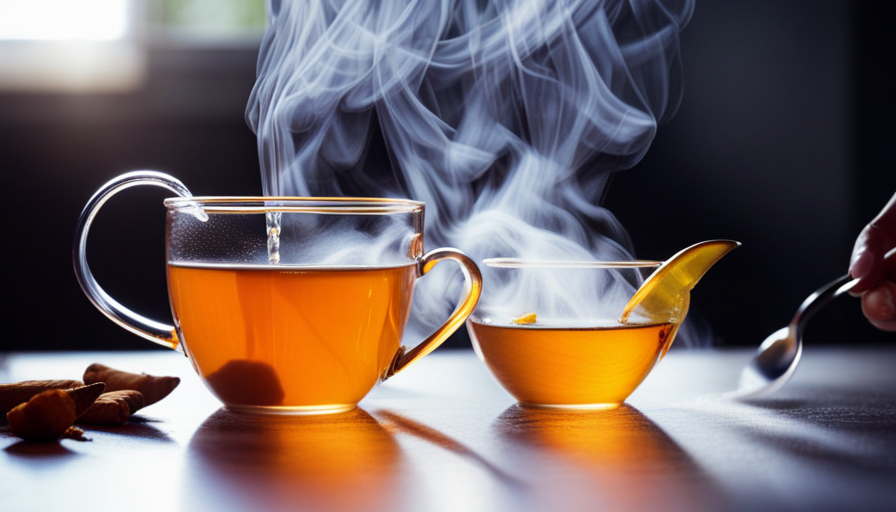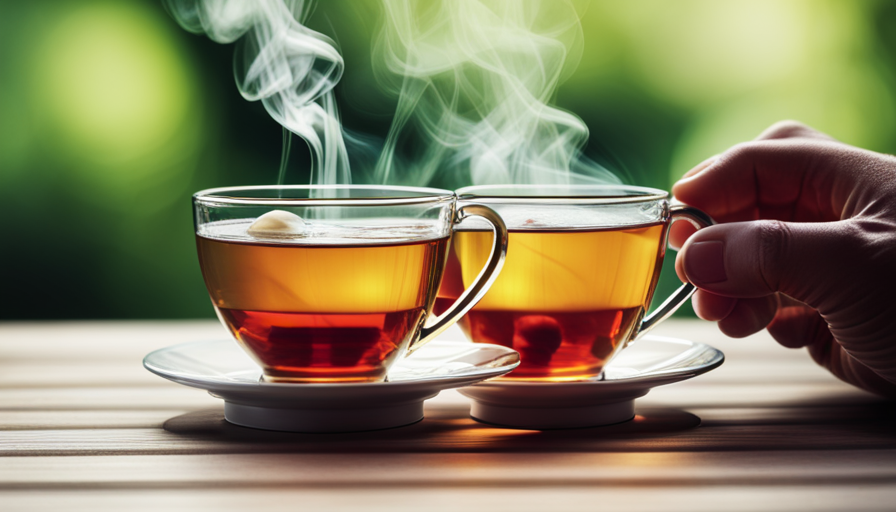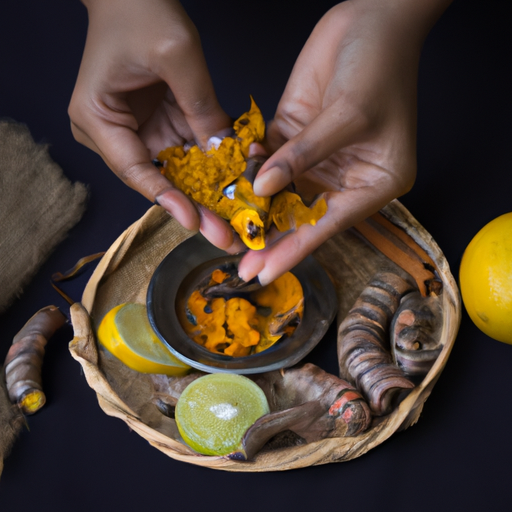Turmeric has been utilized in Ayurvedic medicine for more than 4,000 years to address a range of health issues. This vibrant yellow spice contains curcumin, known for its potent anti-inflammatory and antioxidant qualities.
In fact, studies have shown that consuming turmeric can help reduce inflammation in the body, lower the risk of chronic diseases such as heart disease and cancer, improve brain function, and even alleviate depression.
As a holistic health practitioner, I am always looking for natural ways to improve my wellbeing. One of my favorite ways to incorporate turmeric into my diet is by drinking turmeric tea.
Not only does it taste delicious, but it also provides numerous health benefits. In this article, I will share Dr. Andrew Weil’s recipe for making turmeric tea and provide a step-by-step guide on how to make it yourself at home.
So grab your teapot and let’s get started!
Key Takeaways
- Turmeric tea is a natural way to improve wellbeing and has been used in Ayurvedic medicine for 4,000+ years.
- Dr. Andrew Weil’s turmeric tea recipe includes turmeric powder, ginger powder, honey, lemon juice, and black pepper, with black pepper enhancing curcumin absorption.
- Turmeric tea promotes skin health by improving elasticity, hydration, reducing pigmentation and wrinkles, and can be flavored with honey, ginger, cinnamon, or cardamom.
- Too much turmeric can cause digestive issues and interact with certain medications, so dosage recommendations vary based on individual needs and health status, and pregnant women should be cautious when consuming large amounts of turmeric.
Benefits of Turmeric Tea
You’ll love how turmeric tea can benefit your health in so many ways! Not only is it a delicious and comforting drink, but it also contains a powerful compound known as curcumin, which has strong anti-inflammatory properties.
Inflammation is the root cause of many chronic diseases, such as heart disease, cancer, and Alzheimer’s. By incorporating turmeric tea into your daily routine, you may be able to reduce inflammation in your body and lower your risk of these conditions.
In addition to its anti-inflammatory properties, turmeric tea may also promote skin health. Curcumin has been shown to improve skin elasticity and hydration while reducing pigmentation and wrinkles. It can even help with inflammatory skin conditions like psoriasis and eczema.
So not only will you be doing something good for your internal health by drinking turmeric tea, but you may also see some external benefits as well. And now that you know all about the benefits of this amazing spice, let’s move on to Dr. Andrew Weil’s recipe for making the perfect cup of turmeric tea!
Dr. Andrew Weil’s Recipe for Turmeric Tea
I love making turmeric tea using Dr. Andrew Weil’s recipe! The ingredients he uses are simple: turmeric powder, ginger powder, honey, and lemon juice.
But there is one ingredient that really makes a difference in the tea’s effectiveness: black pepper. Black pepper contains piperine, which enhances the absorption of curcumin, the active compound in turmeric.
So adding a pinch of black pepper to your turmeric tea can help you reap more of its health benefits!
Ingredients
To whip up this tasty turmeric tea, all you need are a few simple ingredients. Turmeric tea comes in different types and recipes, but Dr. Andrew Weil’s recipe calls for only five basic components: water, turmeric powder, ginger root, honey or maple syrup, and lemon juice. These ingredients are rich in antioxidants and anti-inflammatory properties that can boost your immune system and alleviate pain.
To make it easier for you to prepare the recipe, here is a table of the required ingredients:
| Ingredient | Amount |
|---|---|
| Water | 4 cups |
| Turmeric Powder | 1 teaspoon |
| Ginger Root | 2 inches |
| Honey or Maple Syrup | To taste |
| Lemon Juice | Freshly squeezed |
Adding black pepper to your turmeric tea is essential as it helps enhance the bioavailability of curcumin – the active compound found in turmeric responsible for its health benefits. So let’s move on to the next section where we’ll discuss why black pepper is important when making turmeric tea!
Importance of Black Pepper
Adding black pepper to your turmeric brew is crucial because it boosts the absorption of curcumin, allowing you to reap all the health benefits that turmeric has to offer. This pepper pairing increases the bioavailability of curcumin by up to 2000%, which means that your body can absorb more of this potent antioxidant and anti-inflammatory compound.
By including black pepper in your turmeric tea recipe, you’re not only enhancing its flavor but also maximizing its therapeutic potential. Here are three reasons why you should always add a pinch of black pepper when making turmeric tea:
- Black pepper contains piperine, a natural substance that enhances the absorption of curcumin.
- Piperine inhibits certain enzymes in your liver and gut that break down curcumin before it can be absorbed.
- Studies have shown that combining turmeric with black pepper can improve brain function, reduce inflammation, and even prevent cancer.
Now that you know why adding black pepper is important for getting the most out of your turmeric tea, let’s move on to the next section where I’ll guide you through the step-by-step process of making this delicious and healthy beverage.
Step-by-Step Guide to Making Turmeric Tea
First, fetch fresh and fragrant turmeric from your pantry to start steeping a scrumptious tea. Turmeric has been used for centuries as a medicinal herb and is known for its anti-inflammatory properties. Pairing it with black pepper enhances its bioavailability, making it easier for the body to absorb the beneficial compounds.
To make turmeric tea, you’ll need the following ingredients:
| Ingredient | Amount |
|---|---|
| Fresh Turmeric Root | 1-2 inches |
| Black Pepper | A pinch |
| Water | 2 cups |
Start by grating or finely chopping the turmeric root and adding it to a pot of boiling water along with a pinch of black pepper. Let it simmer for about 10 minutes before straining into a cup. You can add honey or lemon juice to taste if desired. Drinking turmeric tea regularly can help reduce inflammation in the body and improve overall health. Experiment with different variations such as adding ginger or cinnamon, and enjoy this delicious drink any time of day.
Now that you know how to make turmeric tea, let’s explore some tips for enhancing its flavor without sacrificing any of its health benefits.
Tips for Enhancing the Flavor of Turmeric Tea
Enhancing the flavor of your turmeric tea can be as simple as adding a few extra ingredients to complement its natural taste. One popular way to do this is by pairing it with honey, which adds sweetness and helps balance out any bitterness from the turmeric.
Another option is to add a slice of fresh ginger, which not only enhances the flavor but also provides additional health benefits. You could also try experimenting with different spices such as cinnamon or cardamom, both of which pair well with turmeric and help create a warm, comforting taste.
When making your tea, be sure to use high-quality ingredients and avoid any artificial sweeteners or flavors that may detract from the overall experience. By taking these steps, you can enjoy all the benefits of turmeric tea while also enhancing its delicious flavor profile.
As much as we love enjoying our cups of turmeric tea, it’s important to remember that there are potential health risks and precautions associated with consuming too much of it. In the next section, we’ll explore some common concerns related to turmeric consumption and how you can safely incorporate this powerful spice into your diet.
Health Risks and Precautions
Now that we’ve talked about how to enhance the flavor of turmeric tea, it’s important to discuss some health risks and precautions associated with consuming it.
While turmeric has many known health benefits, it can also cause some adverse effects if consumed in excess or by certain individuals.
Firstly, turmeric can interact with certain medications such as blood thinners and antacids. It’s important to consult with a healthcare professional before incorporating turmeric into your diet if you’re taking any medications.
Additionally, consuming large amounts of turmeric can lead to digestive issues such as nausea and diarrhea. Prevention measures include starting with small doses and gradually increasing over time and avoiding excessive consumption.
When incorporating turmeric into your diet, dosage recommendations vary depending on the individual’s needs and health status. It’s recommended to consume no more than 1-2 teaspoons per day for most people.
Pregnant women should also be cautious when consuming large amounts of turmeric as it may stimulate the uterus.
Overall, while there are many benefits to consuming turmeric, it’s important to take precautions and consult with a healthcare professional before incorporating it into your diet.
In the next section, we’ll explore other ways to incorporate this spice into our meals without having to brew a cup of tea every day.
Other Ways to Incorporate Turmeric into Your Diet
As someone who’s been incorporating turmeric into my diet for some time now, I’ve found it to be a wonderful addition that’s provided me with numerous health benefits.
From reducing inflammation and improving digestion to boosting brain function and combating disease, turmeric truly is a powerful spice.
While I’ve focused primarily on turmeric tea in this discussion, there are plenty of other ways to incorporate this superfood into your meals.
Overall, I highly recommend giving turmeric a try and seeing how it can improve your overall health and well-being.
Recap of Benefits
Let’s take a moment to review the perks of this golden elixir, shall we?
Turmeric tea benefits go beyond its delicious taste. It contains curcumin, a powerful antioxidant that helps fight inflammation in the body. Drinking turmeric tea may also help boost your immune system and promote healthy digestion.
When it comes to brewing techniques, there are many ways to make turmeric tea. You can use fresh or dried turmeric root, add black pepper for better absorption, and sweeten with honey or maple syrup. Whichever method you choose, be sure to enjoy this nourishing beverage regularly for maximum benefits.
With all these advantages in mind, let’s move on to final thoughts on turmeric tea.
Final Thoughts on Turmeric Tea
You can imagine yourself relaxing with a warm mug of this golden elixir, knowing that turmeric tea is a delicious and healthy way to support your body’s well-being. Not only does it have numerous health benefits, but there are also countless ways to prepare and enjoy it.
Let’s take a look at some of the top turmeric tea benefits in the table below. Additionally, I’ve included some popular turmeric tea recipes for you to try at home. Whether you prefer it hot or iced, sweet or spicy, there’s sure to be a recipe that suits your taste buds. So why not give it a try and experience the many benefits of this wonderful beverage?
| Turmeric Tea Benefits | Turmeric Tea Recipes |
|---|---|
| Reduces inflammation | Golden Milk Turmeric Tea |
| Boosts immune system | Ginger-Turmeric Herbal Tea |
| Improves brain function | Turmeric Chai Latte |
| Lowers risk of heart disease | Spicy Turmeric-Sweet Potato Smoothie |
| Helps manage arthritis pain | Pineapple-Turmeric Smoothie |
As you can see, incorporating turmeric tea into your daily routine can provide significant health benefits. If you’re interested in learning more about this topic or trying out additional recipes, be sure to check out the ‘additional resources’ section below.
Additional Resources
There are various online resources available for those who want to learn more about the benefits and preparation of turmeric tea, including recipe variations, health information, and tips from other tea enthusiasts.
Here are three resources that I’ve found particularly helpful in my own exploration of turmeric tea:
-
The official website of Dr. Andrew Weil offers a recipe for turmeric tea that includes ginger, honey, and lemon juice.
-
Healthline provides an article on the benefits and potential side effects of drinking turmeric tea.
-
The Turmeric Life offers a variety of recipes for different types of turmeric teas, as well as information on the best brands to use.
With these resources at your disposal, you can easily incorporate turmeric tea into your daily routine and experiment with different flavors and preparations.
In the next section, I’ll share my personal experience with making turmeric tea at home.
Share Your Experience
As for my personal experience with preparing turmeric tea, I’ve found that adding a dash of cinnamon and black pepper to the mix gives it an extra level of flavor. The subtle spiciness from these two ingredients perfectly complements the earthy taste of the turmeric.
Overall, I highly recommend experimenting with different spice combinations to find your own unique twist on this warm and soothing beverage. In terms of personal preferences, I like to add a splash of almond milk or honey for sweetness. Some people also prefer using fresh ginger instead of ground ginger for an added freshness.
Additionally, using high-quality organic turmeric powder is important for both flavor and health benefits. Don’t be afraid to customize your turmeric tea recipe based on your own tastes and needs.
Frequently Asked Questions
What is the history of turmeric tea and how did it become popular?
Turmeric tea has a rich history dating back centuries, originating in India and spreading to other parts of Asia. It gained popularity due to its numerous health benefits, including reducing inflammation and aiding digestion. However, it may have side effects for some individuals.
Can turmeric tea be consumed by pregnant women or individuals on medication?
As a trained healthcare professional, it’s important to note that pregnant women and individuals on medication should always consult with their doctor before consuming turmeric tea. While there are many potential benefits, there are also possible side effects to consider.
What are the differences between using fresh turmeric root versus turmeric powder in making tea?
Fresh turmeric root and powder offer similar health benefits, but using fresh turmeric may provide a stronger flavor and higher nutrient content. However, both options can be used to make delicious and nutritious turmeric tea.
How can turmeric tea be incorporated into a weight loss or detoxification regimen?
Incorporating turmeric tea recipes into my weight loss and detox regimen was like adding a powerful tool to my toolbox. The benefits of turmeric tea for digestion made it an essential part of my holistic, natural approach to health.
Are there any cultural or traditional uses of turmeric tea beyond its health benefits?
Turmeric tea has cultural significance in many countries including India and China. Traditional recipes often include black pepper and ginger for added health benefits. It’s a natural way to promote wellness and honor ancient traditions.
Conclusion
Wow, I never knew that a simple cup of turmeric tea could have so many health benefits! After trying Dr. Andrew Weil’s recipe and following the step-by-step guide, I’m hooked on this delicious and nutritious beverage.
Not only does it help with inflammation and digestion, but it also boosts my immune system and promotes healthy skin. But wait, there’s more!
With just a few tips for enhancing the flavor, like adding honey or cinnamon, this tea can become a daily ritual that’s both soothing and satisfying. And don’t forget about all the other ways to incorporate turmeric into your diet – from smoothies to curries, the possibilities are endless.
Overall, I highly recommend giving turmeric tea a try. It may just become your new favorite wellness drink!










